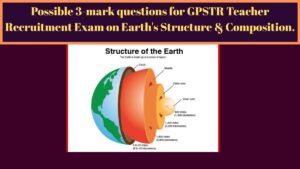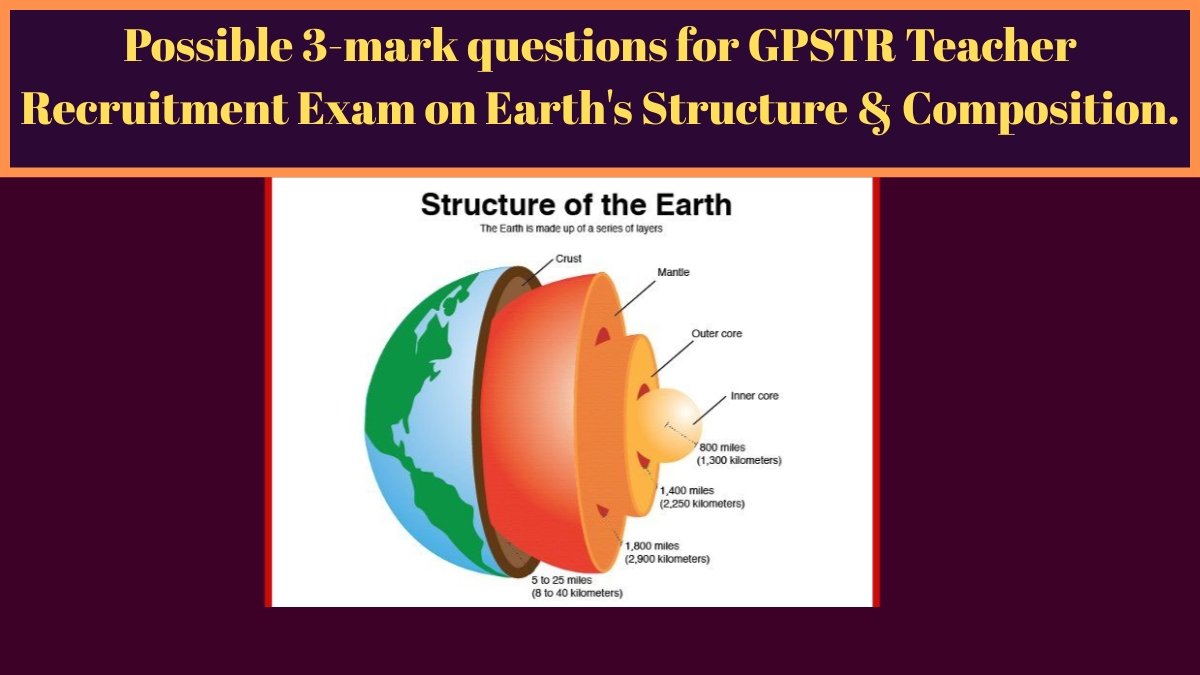Structure and Composition of Earth:Possible 3-mark questions for GPSTR Teacher Recruitment Exam on Earth’s Structure & Composition.

1. _________is the thinnest layer of Earth.
1) Mantle
2) Outer Core
3) Crust
4) Inner Core
Ans:- 3) Crust
• The interior of the Earth is divided into three main zones based on the speed of seismic waves, density of materials, and chemical composition of materials. They are:1) Land cover 2) Mantle 3) Centrifugal.
• The size of the Earth’s crust varies between oceanic and continental regions, with an average depth of about 60 km.
• Mantle:- The innermost part of the Earth’s crust is called the mantle. It extends from 60 km to 2900 km.
• Cenosphere:- This is the innermost layer of the Earth’s interior, extending from the surface of the Earth to a depth of 6371 km.
——————————————————————————
2. The core of the earth is also known as
1) Lithosphere
2) Mesosphere
3) Barysphere
4) Centrosphere
Ans:- 3) Barysphere
• The interior of the Earth below the lithosphere, including both the mantle and the core, is called the barysphere. However, it is sometimes used to refer to only the core or the mantle.
————————————————————————–
3. What is the mean temperature of Earth?
1) 6° Celsius
2) 16° Celsius
3) 26° Celsius
4) 36° Celsius
Ans:- 2) 16° Celsius
• The average temperature on Earth is about 61°F (16°C).
• But temperatures vary around the world depending on the time of year, ocean and air currents, and weather conditions.
• Summers are warm and winters are cold. Also, temperatures are higher near the equator and lower near the poles.
————————————————————————-
4. Which of the following is the most abundant metal on Earth’s crust?
1) Magnesium
2) Iron
3) Copper
4) Aluminium
Ans:- 4) Aluminium
• Aluminum is the most abundant metal in the earth’s crust.
• It is the third most abundant element after oxygen and silicon.
• It makes up about 8% of the weight of the Earth’s crust.
• The Earth’s crust covers less than 1% of the Earth’s volume.
• Oxygen 46.6%, silicon 27.77%, aluminum 8.09% and iron 5%.
—————————————————————————
5. In which two layers of the Earth does the “The Gutenberg Discontinuity” lies?
1) The crust and the mantle
2) The mantle and the core
3) The upper and lower mantle
4) The inner and outer core
Ans:- 2) The mantle and the core
• The Gutenberg discontinuity marks the boundary between two sections of the Earth’s interior.
• It is identified between the lower mantle and the outer core.
• It is found in the Earth’s interior at a depth of about 2,900 km from the surface.
————————————————————————-
Structure and Composition of Earth:Possible 3-mark questions for GPSTR Teacher Recruitment Exam on Earth’s Structure & Composition.

6. Which of the following layers is called “Barysphere”?
1) Earth’s most internal layer
2) Earth’s intermediate layer
3) Earth’s topmost layer
4) Lowest part of the atmosphere where climate changes occur
Ans:-1) Earth’s most internal layer
• The interior of the Earth is divided into three main zones based on the speed of seismic waves, density of materials, and chemical composition of materials.
• They are 1) Earth’s crust 2) Mantle 3) Centripetal,
• Barysphere:- The barysphere ends at a depth of about 2900 km. The zone from this depth to the center of the Earth is called the barysphere. It is 3478 km thick from 2900 km, i.e. from the Gutenberg boundary zone to the center of the Earth, i.e. 6378 km. It has a diameter of about 6956 km. Since this zone is composed of highly concentrated nickel and iron (Fe) minerals, it is symbolically called Nife.
————————————————————————-
7. What is the second most abundant element on Earth’s crust?
1) Carbon
2) Silicon
3) Oxygen
4) Hydrogen
Ans:-2) Silicon
• Silicon is the second most common element in the crust after oxygen.
• In the crust, it combines with oxygen to form silicate minerals. It is found in sand, which is the most abundant and readily available resource on Earth. Silicon is also obtained from quartzite, mica, and talc.
————————————————————————-
8. Approximately what is the normal rate of temperature rise with depth from the surface of the Earth to the interior of the Earth?
1) 1°C per 185 meter
2) 1°C per 185 feet
3) 1°C per 32 meter
4) 1°C per 32 feet
Ans:- 3) 1°C per 32 meter
• Various observations show that the rate of temperature increase is not uniform from top to bottom towards the centre of the Earth.
• Initially, this temperature increase rate averages 1°C for every 32m increase in depth.
• In the upper 100 km, the temperature increases at a rate of 120°C per km and in the next 300 km, it increases at a rate of 200°C per km. But as you go deeper, this rate decreases to just 100°C per km.
————————————————————————–
9. Which part of the Earth has the abundance of nickel and iron?
1) Sial
2) Seema
3) Nife
4) No option is correct.
Ans:- 3) Nife
• Cenosphere:- This is the innermost layer of the Earth’s interior, extending from the surface of the Earth to a depth of 6371 km.
• The central sphere is dominated by nickel and iron materials, called NIFE. Its average density is 5.5 to 1 lgm/cm².
—————————————————————————-
10. Crust is a layer______________
1) Having 8 to 40 km thickness
2) Having 20 to 60 km thickness
3) Having 5 to 15 km thickness
4) Having 8 to 20 km thickness
Ans:- 1) Having 8 to 40 km thickness
• Continental crust (intercontinental crust): This is the uppermost layer of the earth’s crust and is thicker than the oceanic crust. The thickness of the continental crust is 5 km. The continental crust is about 60 km. thick at the base of the mountains. Its average density is 2.7 g/sq.km.
————————————————————————-
11. What is the name of the second layer of the Earth’s three concentric layers?
1) Sial
2) Seema
3) Nife
4) No option is correct.
Ans:- 2) Seema
• The Earth has three layers:
• Outer layer:- continents [SiAl – silica + aluminum The main mineral components of the continental mass are silica.
• Mantle and oceanic crust:- SiMa (Silica + Magnesium) Oceanic
• The crust consists mainly of crust. Typically, crust is basalt when it reaches the surface. Therefore, this layer is sometimes called the ‘basalt layer’. The crust layer is also called the ‘basal crust’ or ‘basal layer’ because it is the lowest layer of the crust.
• Because the ocean floors are mainly composed of crust, it is sometimes also called ‘oceanic crust’.
• Inner layer:- Core [NiFe-nickel+ferrous]. The outer part is liquid and the inner part is solid.
———————————————————————-
12.Match the following:
A. mantle – 1. Heaviest rocks of the lithosphere
B. Sima – 2. The lower layers of the Earth’s crust
C. Sial – 3. Lightest rocks of the lithosphere
D. Bill – 4. A small peninsula
1) 3 1 4 2
2) 4 3 2 1
3) 2 1 3 4
4) 1 2 3 4
Ans:- 3) 2 1 3 4
• Mantle:
• The inner part of the mantle is called the mantle. The boundary zone between the mantle and the mantle is called the mesozoic. It is about 2900 km thick. It is divided into two parts. 1) The density of the upper layer of the mantle is 3.4-4.4 gm/cm³ 2 700 .. .
• The upper part of the continental crust is called the sial. It is composed mainly of silica and aluminum. Its density is 2.7 gm/cm³. The lower part of the crust is called the oceanic crust, which is composed mainly of silica and magnesium and is called SIMA. It has a density of 3.0 gm/cm³.
—————————————————————————-





